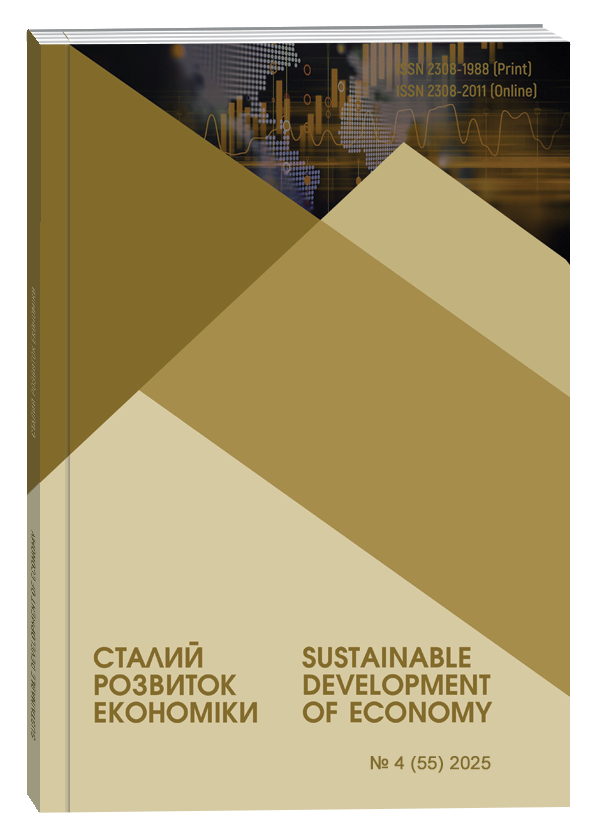STRUCTURE OF THE SYSTEM OF INITIAL PUBLIC OFFERING OF SHARES BY ENTERPRISES
Abstract
The article aims to study the structure of the initial public offering (IPO) system for enterprises, identifying its main elements and interrelationships. It also aims to generalise theoretical and practical approaches to organising IPOs, taking into account international and domestic experience. This article examines the structure of the initial public offering (IPO) system, an important tool for mobilising investment resources and fostering enterprise competitiveness in the context of globalisation. It reveals the essence of an IPO as the first public sale of shares and analyses the legislative definitions of this phenomenon in the United States and Ukraine. The scientific approaches to understanding IPOs in foreign economic literature are identified, emphasising the role of IPOs in raising capital and creating market opportunities for shareholders. The advantages of IPOs highlighted in domestic studies are categorised as follows: the accumulation of financial resources over the long term; the objective determination of enterprise value; capitalisation growth; the liquidity of shares; the absence of a debt burden; and the improvement of corporate reputation. Particular attention is paid to the European experience of organising IPOs, including the selection of a stock exchange and listing standards, the determination of the type and volume of shares, the methods of their placement, the financial reporting requirements, the implementation of structural changes within the company and the planning of the use of proceeds. The IPO system is structured as a set of interconnected elements: the issuer, the stock exchange, investment intermediaries, regulatory authorities and investors. It is emphasised that the IPO system can only function effectively with a developed stock market infrastructure, a transparent regulatory environment, and a high level of trust among participants. It is noted that, for Ukrainian enterprises, introducing an IPO is a promising way to increase capitalisation, reputation, and integration into the global capital market; however, its effectiveness depends on stock market infrastructure development and institutional trust levels.
References
Верба В. А., Ковальчук О. П. Тенденції розвитку фондового ринку України у контексті світових тенденцій. Вісник Київського національного університету імені Тараса Шевченка. 2019. № 56(2). C. 89-97.
Давиденко Н.М. Оцінювання ефективності корпоративного управління акціонерними товариствами. Вісник Львівської комерційної академії. Серія: Економічна. 2011. Вип. 35. С. 108-111.
Давиденко Н.М. Концептуальні підходи до капіталізації підприємств. Економічний часопис Східноєвропейського національного університету імені Лесі Українки. 2016. № 1. С. 62-67.
Давиденко Н.М. Переваги залучення фінансових ресурсів аграрними корпораціями шляхом виходу на іноземні фондові біржі. Облік і фінанси. 2012. Вип. 3. С. 96–101
Давиденко Н.М. Корпоративне управління в акціонерних товариствах: монографія. Київ: [б. в.]. 2011. 355 с.
Ляховець О. О. Динаміка капіталізації українського фондового ринку. Наукові праці Чорноморського державного університету імені Петра Могили. Серія: Економіка. 2012. № 189(177). С. 31-34.
Мазур І., Сазонов Р. Теоретико-методологічне значення міжнародного лістингу акцій для інвесторів та емітентів. Вісник Київського національного університету імені Тараса Шевченка. 2018. № 2(197). С. 31-36.
Baker M., Wurgler J. Market timing and capital structure. The Journal of Finance. 2002. № 57 (1). С. 1–32. DOI: https://doi.org/10.1111/1540-6261.00414 (дата звернення: 24.09.2025).
Fulgieri P., Lukacs D. Information production, dilution costs, and optimal security design. The Journal of Finance. 1999. № 54 (1). С. 115–149. DOI: https://doi.org/10.1111/0022-1082.00101 (дата звернення: 22.09.2025).
Pagano M., Panetta, F., Zingales L. Why do companies go public? An empirical analysis. The Journal of Finance. 1998. № 53 (1). Р. 27–64. DOI: https://doi.org/10.1111/0022-1082.25448 (дата звернення: 28.09.2025).
Ritter J. R., Welch I. A review of IPO activity, pricing, and allocations. The Journal of Finance. 2002. № 57 (4). Р. 1795–1828. DOI: https://doi.org/10.1111/1540-6261.00478 (дата звернення: 14.09.2025).
Verba V. A., Kovalchuk O. P. (2019) Tendentsii rozvytku fondovoho rynku Ukrainy u konteksti svitovykh tendentsii [Trends in the development of the Ukrainian stock market in the context of global trends]. Visnyk Kyivskoho natsionalnoho universytetu imeni Tarasa Shevchenka. No. 56(2), pp. 89-97. (in Ukrainian)
Davydenko N. M. (2011) Otsiniuvannia efektyvnosti korporatyvnoho upravlinnia aktsionernymy tovarystvamy [Assessing the effectiveness of corporate governance by joint stock companies]. Visnyk Lvivskoi komertsiinoi akademii. Seriia: Ekonomichna. Vol. 35, pp. 108-111. (in Ukrainian)
Davydenko N. M. (2016) Kontseptualni pidkhody do kapitalizatsii pidpryiemstv [Conceptual approaches to enterprise capitalisation]. Ekonomichnyi chasopys Skhidnoievropeiskoho natsionalnoho universytetu imeni Lesi Ukrainky. no 1, pp. 62-67. (in Ukrainian)
Davydenko N. M. (2012) Perevahy zaluchennia finansovykh resursiv ahrarnymy korporatsiiamy shliakhom vykhodu na inozemni fondovi birzhi [Advantages of attracting financial resources by agricultural corporations through listing on foreign stock exchanges]. Oblik i finansy. Vol. 3, pp. 96–101. (in Ukrainian)
Davydenko N. M. (2011) Korporatyvne upravlinnia v aktsionernykh tovarystvakh: monohrafiia [Corporate governance in joint stock companies: monograph]. Kyiv.: [b. v.]. 355 p. (in Ukrainian)
Lyakhovets O. O. (2012) Dynamika kapitalizatsii ukrainskoho fondovoho rynku [Dynamics of capitalisation of the Ukrainian stock market]. Naukovi pratsi Chornomorskoho derzhavnoho universytetu imeni Petra Mohyly. Seriia: Ekonomika. no. 189(177), pp. 31-34. (in Ukrainian)
Mazur I., Sazonov R. (2018) Teoretyko-metodolohichne znachennia mizhnarodnoho listynhu aktsii dlia investoriv ta emitentiv [Theoretical and methodological significance of international stock listing for investors and issuers]. Visnyk Kyivskoho natsionalnoho universytetu imeni Tarasa Shevchenka, vol. 2(197), pp. 31-36. (in Ukrainian)
Baker M., Wurgler J. (2002). Market timing and capital structure. The Journal of Finance, no. 57 (1), pp. 1–32. DOI: https://doi.org/10.1111/1540-6261.00414
Fulgieri P., Lukacs D. (1999). Information production, dilution costs, and optimal security design. The Journal of Finance, no. 54 (1), pp. 115–149. DOI: https://doi.org/10.1111/0022-1082.00101
Pagano M., Panetta F., Zingales L. (1998). Why do companies go public? An empirical analysis. The Journal of Finance, no. 53 (1), pp. 27–64. DOI: https://doi.org/10.1111/0022-1082.25448
Ritter J. R., Welch I. (2002). A review of IPO activity, pricing, and allocations. The Journal of Finance, no. 57 (4), pp1795–1828. DOI: https://doi.org/10.1111/1540-6261.00478


